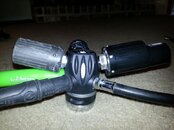paulw
Contributor
I dove my new LYNX for the first time yesterday and thought I would post a quick report. I had not seen the manual yet but setting it up was pretty straight forward and now that I have seen the manual I did it correctly.
The transmitter is larger than my Oceanic and most others I have seen but I had no problem installing the it, by the way I use Aqualung Legend LX Supreme. I did notice after installing the transmitter I could wiggle it a little so I ask Eric and he informed me this was normal. At the dive site I turned it on and on the surface in bright sunlight I had a hard time seeing the display but once I submerged it was extremely bright even in very bad visibility, at one point I mucked up the vis to probably zero and had no issues seeing the display. I ask my buddy to let me know what he could see and he was impressed that although he could barely make me out he could see the LYNX. I was also using my Datamask and compared the information both delivered and they were very close on everything but dive time remaining where the Datamask constantly gave me about a 10 to 15 minutes longer dive time but after reading the manual the Lynx calculates "Air Time" with a low point of 700 psi where I have my Oceanic computers set to 400 psi, this might be be the difference and I wish this was user changeable. I tried the compass and it worked nicely but I have old eyes and wish it was a little larger, the dive info was nice but maybe have an option without that so the compass is larger. The tap system instead of buttons works great but I admit I have dove Liquivision computers before. I waited a while to buy a new computer because I wanted OLED and air integration along with some tec abiliyies if I wanted to use them and I really like this computer. I am looking forward to trying a locator transmitter for diving unknown areas.
Things I would like to see are the ability to decide the low air from 700 psi to what I want, a larger compass and maybe the ability to change some display information and color's. I do have a concern and that is the robustness of the transmitter, removing it after each use just doesn't seem probable and in when diving from small boat (like panga's / sixpacks) there is very little room and gear can get banged around but I will find out.
After two dives I can report I am happy I bought it.
[video=youtube;wm7w3drhY4k]http://www.youtube.com/watch?v=wm7w3drhY4k&list=UUJVpKrueGzpmElZ-ETGxhsg&index=1[/video]
The transmitter is larger than my Oceanic and most others I have seen but I had no problem installing the it, by the way I use Aqualung Legend LX Supreme. I did notice after installing the transmitter I could wiggle it a little so I ask Eric and he informed me this was normal. At the dive site I turned it on and on the surface in bright sunlight I had a hard time seeing the display but once I submerged it was extremely bright even in very bad visibility, at one point I mucked up the vis to probably zero and had no issues seeing the display. I ask my buddy to let me know what he could see and he was impressed that although he could barely make me out he could see the LYNX. I was also using my Datamask and compared the information both delivered and they were very close on everything but dive time remaining where the Datamask constantly gave me about a 10 to 15 minutes longer dive time but after reading the manual the Lynx calculates "Air Time" with a low point of 700 psi where I have my Oceanic computers set to 400 psi, this might be be the difference and I wish this was user changeable. I tried the compass and it worked nicely but I have old eyes and wish it was a little larger, the dive info was nice but maybe have an option without that so the compass is larger. The tap system instead of buttons works great but I admit I have dove Liquivision computers before. I waited a while to buy a new computer because I wanted OLED and air integration along with some tec abiliyies if I wanted to use them and I really like this computer. I am looking forward to trying a locator transmitter for diving unknown areas.
Things I would like to see are the ability to decide the low air from 700 psi to what I want, a larger compass and maybe the ability to change some display information and color's. I do have a concern and that is the robustness of the transmitter, removing it after each use just doesn't seem probable and in when diving from small boat (like panga's / sixpacks) there is very little room and gear can get banged around but I will find out.
After two dives I can report I am happy I bought it.
[video=youtube;wm7w3drhY4k]http://www.youtube.com/watch?v=wm7w3drhY4k&list=UUJVpKrueGzpmElZ-ETGxhsg&index=1[/video]





